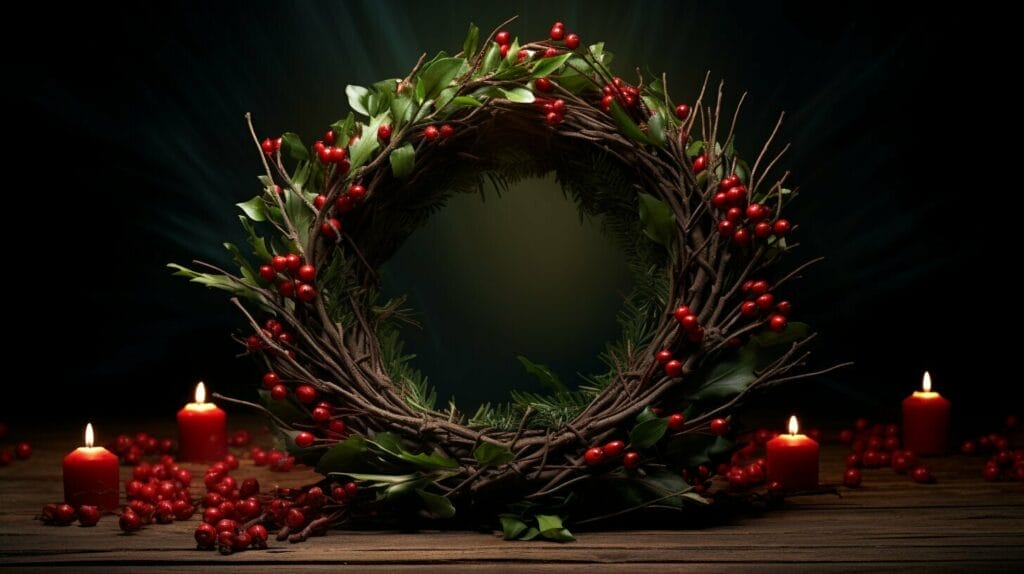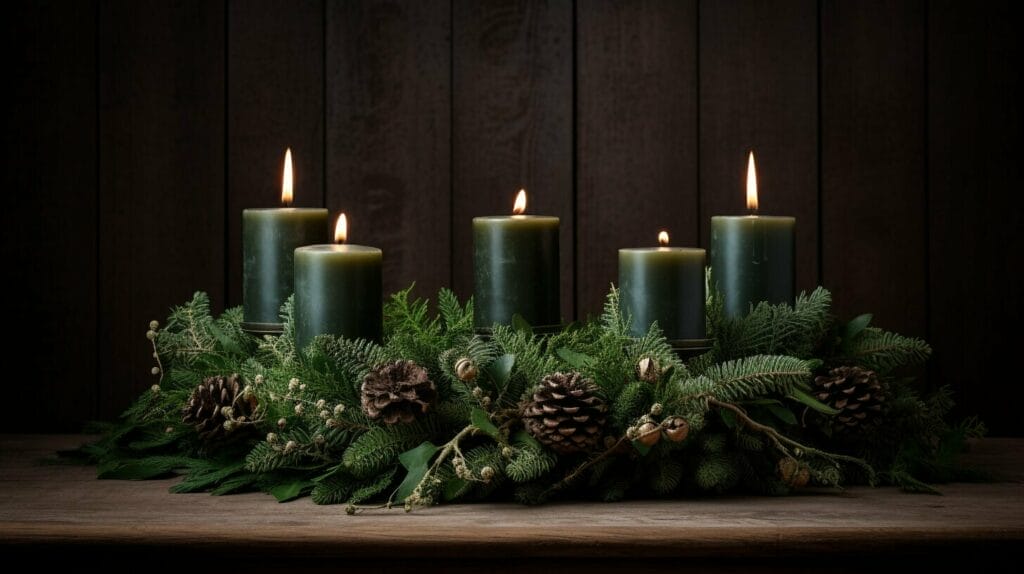Christmas Wreaths Origin – Where Tradition Meets Tidings
It’s that time of the year, and Christmas wreaths are a familiar sight. These beautiful decorations, usually made of evergreen branches, are a symbol of the holiday season. But have you ever wondered about the Christmas wreaths origin and the history behind them?

The tradition of wreaths dates back to ancient times. The Romans used wreaths as a symbol of victory and honor, while the Greeks used them to crown the winners of the athletic games.
But it was the Christians who adapted this tradition and used it to celebrate the birth of Jesus Christ. The first Christmas wreath, made of evergreen branches, was created in Germany in the 16th century.
Christmas wreaths now come in various styles and designs, but they still represent the same message – the hope and joy of the holiday season.
Key Takeaways:
- Christmas wreaths have a long and rich history dating back to ancient times.
- The tradition of Christmas wreaths originated in Germany in the 16th century.
- Christmas wreaths are a symbol of hope and joy during the holiday season.
- Today, Christmas wreaths come in various styles and designs.
- Christmas wreaths have both religious and cultural significance.
Ancient Customs and Symbolism of Wreaths
Wreaths have been used in various celebrations throughout history, symbolizing different beliefs and customs. The circular shape of wreaths represents the cycle of life, continuity, and eternity. They were typically made of evergreen branches, which kept their freshness throughout the winter season.
Ancient Greeks and Romans hung wreaths on their doors as a symbol of victory and honor. They often made wreaths using olive branches, which represented peace.
In Christianity, wreaths are associated with the Advent season, representing the four weeks leading up to Christmas.
“The Advent wreath is a circular garland of evergreen branches representing eternity. On that wreath, four or five candles are typically arranged. During the season of Advent, one candle on the wreath is lit each Sunday as a part of the Advent services.”
The candles on the wreath represent different themes: hope, love, joy, and peace. The fifth candle, if present, represents the Christ candle, which is lit on Christmas Eve.
The use of wreaths in ancient cultures also had medicinal purposes. They were believed to possess healing powers, and people would hang them in their homes or wear them around their necks.
The symbolism and customs surrounding wreaths have evolved over time, but their popularity as festive decorations remains strong today.

As you prepare for the Christmas season, you’ll likely see Advent wreaths adorning the entrances of churches and homes alike. These wreaths, typically made of evergreen branches with four candles nestled inside, have a deep history and hold significant meaning. Let’s explore the origin of Advent wreaths and the traditional Christmas wreaths that they have evolved from.
Advent wreaths originated in northern Europe in the early 19th century and were used to symbolize the countdown to Christmas. The wreath’s circular shape represents eternity while the evergreen branches signify eternal life and hope. The candles, which are lit each Sunday of Advent, represent hope, love, joy, and peace respectively.
The tradition of lighting candles during the Advent season dates back to the 16th century, when German Lutherans would light candles to count the days until Christmas. The modern Advent wreath was introduced by a Protestant pastor, Johann Hinrich Wichern, in 1839. Wichern created a wreath with 24 candles for the children in his care to light each day of Advent. However, the modern Advent wreath we know today, with four candles, was not standard until the 20th century.
The Advent wreath has become a beloved and essential part of the Christmas season, symbolizing the anticipation and preparation for the birth of Jesus. It serves as a reminder to slow down and reflect on the meaning behind Christmas wreaths and the holiday season as a whole.
As you light each candle, you can pause and meditate on the meaning behind the traditional Christmas wreaths, the wreaths in ancient celebrations, and the meaning behind Christmas wreaths for the modern era.

In addition to their spiritual significance, Advent wreaths also add a festive touch to our homes during the holiday season. While traditionally displayed in churches, Advent wreaths can also be hung on doors or displayed as table centerpieces. They serve as a visual reminder of the upcoming holiday and the importance of the season.
Advent wreaths have a rich history that dates back centuries. Their symbolism and meaning have evolved over time and continue to hold significant value in modern times. Take the time to appreciate this beloved tradition and reflect on its significance as you prepare for the Christmas season.
Evolution of Christmas Wreaths
Over time, the materials, styles, and designs of Christmas wreaths have undergone significant changes, while some festive traditions have remained cherished aspects of the holiday season. Originally, wreaths were made from evergreens and hung on doors to symbolize strength and provide protection from evil spirits and winter weather. The Yuletide wreaths of Scandinavia, for example, featured candles and other decorations.
As the centuries passed, the evergreen wreaths evolved to include other materials, such as holly, mistletoe, and berries. These materials carried their own significance to ancient peoples, further enriching the symbolism of the wreaths. In the Victorian era, wreaths became more ornate, incorporating ribbons, bows, and even small toys for children.

Today, Christmas wreaths come in a wide variety of styles and designs. Some are made from artificial materials, while others still feature real evergreens and natural elements. They can be simple and elegant or lavish and opulent, depending on personal style preference or regional traditions.
One popular Christmas wreath tradition is the Advent wreath. This wreath, typically made from evergreens and adorned with candles, is used to mark the weeks leading up to Christmas and symbolizes the anticipation of the birth of Jesus.
Another festive tradition associated with Christmas wreaths is the laying of wreaths on the graves of fallen soldiers to honor their memory during the holiday season. This practice dates back to the early 1900s and has become an important part of many holiday celebrations.
Whether you prefer traditional evergreen wreaths or modern, creative styles, Christmas wreaths remain a beloved and essential part of Christmas traditions and holiday decor. From their ancient origins to their current-day evolution, wreaths continue to bring joy, beauty, and meaning to the Christmas season.
Christmas Wreaths Today – Cultural Significance and Door Decor
Today, Christmas wreaths still symbolize the holiday season and are popularly used to decorate homes and businesses alike. Wreaths have become an integral part of holiday traditions around the world. In the United States, wreaths are commonly used to decorate doors, mantels, and windows, with many families choosing to make their wreaths from scratch using pine cones, holly, and other natural materials.
Throughout Europe, Christmas wreaths are often decorated with candles, ribbons, and ornaments, and are displayed in public areas to spread Christmas cheer and holiday spirit. In some cultures, the wreath is even used as a symbol of hospitality and welcome, with a wreath hung on the door to invite guests into the home.
Moreover, the bright colors and festive ornaments that adorn many Christmas wreaths are a symbol of joy and celebration, reminding us to take a moment to enjoy the company of our loved ones during this special time of year.
Whether you choose to decorate your home with a traditional evergreen wreath or a more modern version adorned with lights and ornaments, the Christmas wreath remains an enduring symbol of the holiday season, reminding us of the magic and wonder of this special time of year.
FAQ
Q: What is the origin of Christmas wreaths?
A: Christmas wreaths have their origins in ancient cultures, where they were used to symbolize strength and endurance during the winter months. The circular shape of the wreaths represents eternity and unity.
Q: What is the symbolism behind wreaths?
A: Wreaths are often associated with various symbols, such as victory, honor, and celebration. They have been used in ancient ceremonies and are still widely used today to represent unity and welcoming.
Q: What is the significance of Advent wreaths?
A: Advent wreaths originated as a Christian tradition to mark the four weeks leading up to Christmas. Each candle on the wreath represents a different aspect of the Advent season, such as hope, peace, joy, and love.
Q: How have Christmas wreaths evolved over time?
A: Christmas wreaths have evolved in terms of materials used and design styles. In ancient times, wreaths were made from fresh greenery, while today, artificial materials are often used. Additionally, wreath designs have become more creative and personalized.
Q: What is the cultural significance of Christmas wreaths today?
A: Christmas wreaths have cultural significance as festive decorations for our doors and as symbols of holiday cheer. They add a touch of warmth and joy to our homes during the holiday season and are often associated with traditions of welcoming and hospitality.




